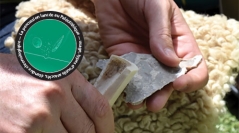

 Comptes Rendus Palevol
20 (11) - Pages 175-198
Comptes Rendus Palevol
20 (11) - Pages 175-198Layer 6 of Orgnac 3 corresponds to a cave occupation, dated to the end of MIS 9. It yielded numerous lithic and paleontological remains, and witnesses of diverse hominin activities. This paper aims to consider percussive activities from both lithic material and fauna, according to a technological and traceologicalological analysis. Knapping activities are dominant, based on the presence of hammerstones and retouchers (from bone and lithic materials). Recycling phenomena were also highlighted, with cores used as hammerstones. A flake-bulb presents also typical wear marks due to its use as retoucher (“éclat à bulbe piqueté”). These phenomena are usual during the Middle Palaeolithic and are here presented from the first stages of these lithic techno-complexes. Among the shaped pieces, a chopper bears macro-wear marks typical of use in launched percussion on a non-mineral hard material (bone?). Herbivorous remains present anthropic fractures for marrow extraction, diaphysis fragments being further punctually used as retouchers. Percussive activities have an important role in prehistoric lifeways (knapping activities, acquisition and transformation of raw materials linked to subsistence). The diversity of the percussive tool-kit testifies to a technological specialisation, while recycling shows the hominins adaptive skills to their environment.
Hammer, retoucher, launched percussion, Early Middle Palaeolithic, recycling